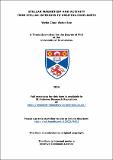Files in this item
Stellar magnetism and activity : from stellar interiors to orbiting exoplanets
Item metadata
| dc.contributor.advisor | Jardine, Moira | |
| dc.contributor.author | See, Wyke Chun Victor | |
| dc.coverage.spatial | [xxiv], 123, [12] p. | en_US |
| dc.date.accessioned | 2016-10-04T10:14:43Z | |
| dc.date.available | 2016-10-04T10:14:43Z | |
| dc.date.issued | 2016-11-30 | |
| dc.identifier | uk.bl.ethos.694559 | |
| dc.identifier.uri | https://hdl.handle.net/10023/9602 | |
| dc.description.abstract | The study of magnetic fields on low-mass stars is important due to their ubiquity. They are responsible for phenomena spanning a wide range of spatial and temporal scales. Over the last two decades, the Zeeman-Doppler imaging (ZDI) technique has been used to study the topologies of stellar magnetic fields. A great deal has been learnt about how the magnetic characteristics of cool dwarfs vary as a function of parameters such as mass, rotation or age. In this thesis, I assemble a sample of stars with Zeeman-Doppler maps. I study their poloidal and toroidal components as a function of fundamental parameters and also in relation to activity cycles. I find that the relationship between poloidal and toroidal fields is different for stars above and below the fully convective boundary, in line with previous ZDI studies. I also find that the fields of strongly toroidal stars must be generated axisymmetrically. With regards to activity cycles, I find that so called “inactive branch" stars appear to remain poloidal throughout their activity cycle while so called “active branch" stars appear to be able to generate strong toroidal fields. Magnetic activity can also interact with exoplanets that may be orbiting a star. In this thesis, I consider two such interactions. The first is the compression of planetary magnetospheres by stellar winds. Sufficiently powerful winds can strip a planet of its atmosphere and render it uninhabitable. However magnetospheric shielding can provide some protection. I show that planets around 0.6 M⊙ - 0.8 M⊙ stars are the most likely to be able to protect their atmospheres. The second interaction I consider is exoplanetary radio emission. I present a wind model and show that exoplanetary radio emissions will depend strongly on the structure of the magnetic field structure of the central star. | en_US |
| dc.language.iso | en | en_US |
| dc.publisher | University of St Andrews | |
| dc.rights | Attribution-NonCommercial-NoDerivatives 4.0 International | * |
| dc.rights.uri | http://creativecommons.org/licenses/by-nc-nd/4.0/ | * |
| dc.subject | Magnetism | en_US |
| dc.subject | Activity | en_US |
| dc.subject | Stars | en_US |
| dc.subject | Exoplanets | en_US |
| dc.subject.lcc | QB817.5S4 | |
| dc.subject.lcsh | Stars--Magnetic fields | en_US |
| dc.subject.lcsh | Stellar activity | en_US |
| dc.subject.lcsh | Low mass stars | en_US |
| dc.subject.lcsh | Extrasolar planets | en_US |
| dc.title | Stellar magnetism and activity : from stellar interiors to orbiting exoplanets | en_US |
| dc.type | Thesis | en_US |
| dc.contributor.sponsor | Science and Technology Facilities Council (STFC) | en_US |
| dc.type.qualificationlevel | Doctoral | en_US |
| dc.type.qualificationname | PhD Doctor of Philosophy | en_US |
| dc.publisher.institution | The University of St Andrews | en_US |
The following licence files are associated with this item:
This item appears in the following Collection(s)
Except where otherwise noted within the work, this item's licence for re-use is described as Attribution-NonCommercial-NoDerivatives 4.0 International
Items in the St Andrews Research Repository are protected by copyright, with all rights reserved, unless otherwise indicated.


